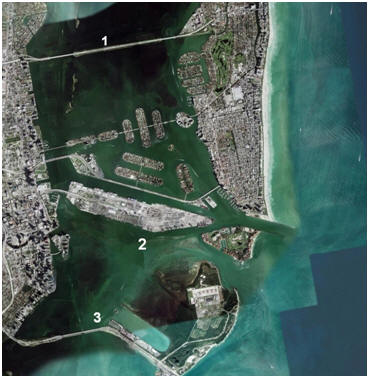Thomas P.
Carsey, Ph.D. |
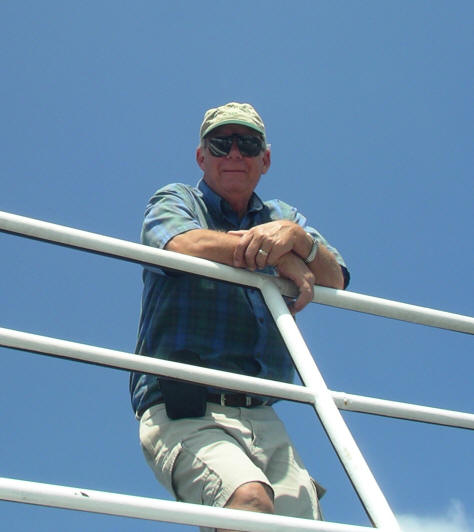 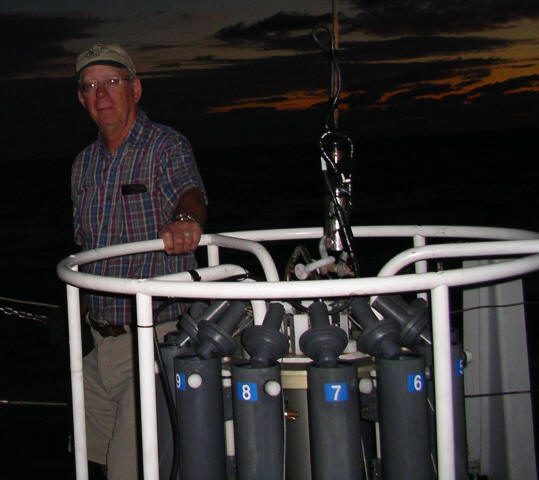 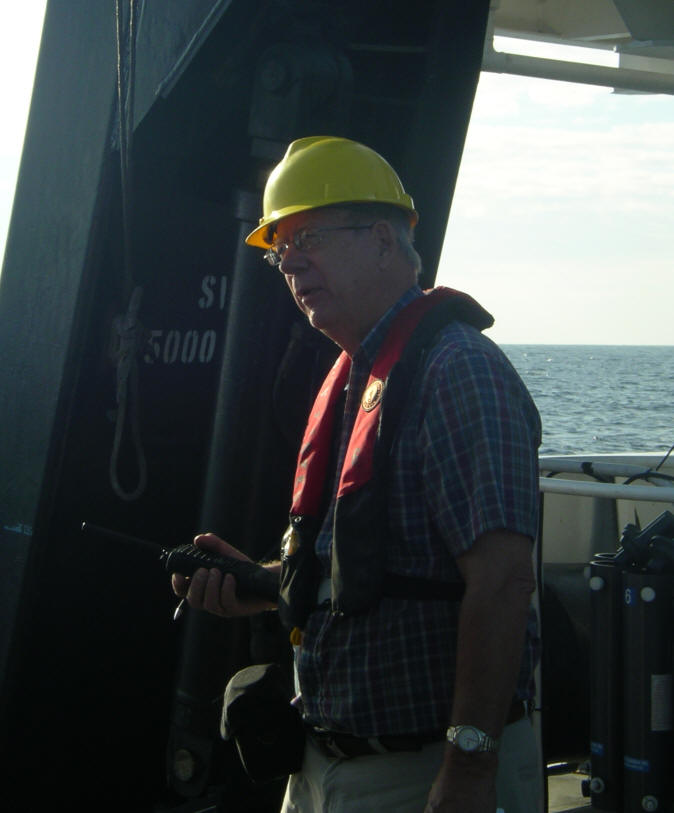 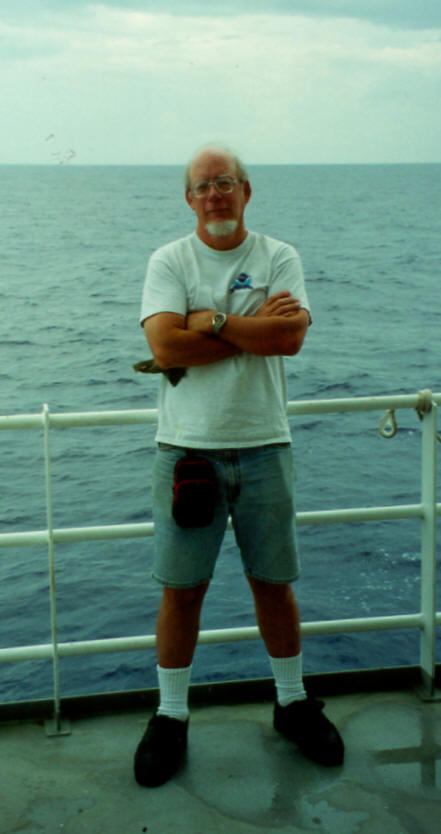
|
|
Research
Interests The FACE program is designed to understand the many controlling oceanographic and coastal environmental factors that influence Florida public health and coastal biota, and to provide this knowledge to the area's environmental regulators, resource managers, utility operators, and to the public. The broad objectives of the studies include
The study area of FACE covers 467 km of coastline in Miami-Dade to Brevard counties. The area includes six treated wastewater plants [TWWP]: Miami Central, Miami North, Hollywood, Broward, Boca Raton, and South Central, which together contribute ~1 million cubic meters (284 millions of gallons) per day to the region. In addition, this coastal area receives fresh water discharged through six inlets, from the Miami Harbor inlet in the south to the Boynton inlet in the north. This area is the home of nearly 5.5 million people (U S Census Bureau, 2006) and an economy heavily dependent on a healthy offshore environment. Web Link: http://www.aoml.noaa.gov/themes/CoastalRegional/projects/faceweb.html
Biscayne Bay Turbidity This project will obtain high-quality measurements of turbidity, ocean current speed and direction, and a variety of oceanographic measurements at three sites in the northern portion of Biscayne Bay (see figure). The project is lead by Jack Stamates. These measurements will provide a baseline of "prior"
measurements at selected locations of the Bay before the commencement of
proposed dredging operation at the Port of Miami. This effort will also
focus on understanding the underlying factors that contribute to turbidity
variability at these three sites and examine the relationship between
turbidity and total suspended solids (TSS) with light attenuation.
The ultimate goal is to quantify the temporal variability of the turbidity levels at these sites under varying environmental conditions. Quantifying the relationship between environmental conditions and turbidity levels will allow for the estimation of what turbidity conditions may be expected at these sites during the dredging operations and thus accurately partition the impact of dredging operations from natural variability. Continuous measurements include currents, acoustic backscatter, turbidity, pressure (depth), temperature, conductivity (salinity), chlorophyll-a, and chromophoric dissolved organic matter (CDOM). These underway measurements will be calibrated with grab samples collected bi-weekly for TSS, light attenuation, chlorophyll a and SEM analysis. Photographs will be obtained from the top of the Four Seasons Hotel (~205 m high) using a time lapse camera to document the visual turbidity signal at sites 2 and 3. Spatial measurements of the turbidity and current field from small boat surveys will augment the fixed instrument data providing insight into the spatial variability of the turbidity field in the regions of interest and examine the effect of advection of turbidity plumes into the study sites. The continuous data sets will provide a 1-year-long record of turbidity, currents, and suspended solid measurements at selected sites in northern Biscayne Bay along with environmental conditions. Meteorological data will be used to examine the contribution of wind-driven turbidity to the overall turbidity regime. Electron scanning microscopy and gravimetric analysis of water column samples will establish the relationship of turbidity with particle load, particle composition and particle size. Web Link: http://www.aoml.noaa.gov/themes/CoastalRegional/projects/BB-turbidity/BB-turb.htm
Petroleum and Oil Spill Research: the Blind Pass Petroleum in Sediments Project The Blind Pass Petroleum in Sediments (BPPES) program is
designed to map the location of petroleum-based sediments in and around of
Blind Pass (near Tampa), Florida. The project was lead by John Proni
and Chuck Featherstone. In 1993 a collision of tanker barges resulted in the discharge of approximately 330,000 gallons of #6 fuel oil from the Bouchard #155 and of about 32,000 gallons of Jet A, diesel and gasoline oil into Blind Pass, and in Boca Ciega Bay, near Tampa, Florida. 1999, the U.S. Army Corps of Engineers and Pinellas County conducted geotechnical borings in those passes to determine the sand quality and identify any areas of unsuitable material for beach renewal. With minimal indication of the presence of residual oil, dredging activities in Blind Pass began in January 2000. During these activities, small pockets of petroleum hydrocarbon, approximately 50 gallons each, were discovered. These areas are used a sources of beach sand for renourishment purposes. This project was conducted in anticipation of future Blind Pass dredging operations. As part of this effort, sediment cores were collected by the University of South Florida (USF) and analyzed by AOML and UM/RSMAS. At AOML, the samples were analyzed using a new instrument, the fuel fluorescence detector (FFD). In conjunction with those analyses, petroleum hydrocarbon characterization and calibration using GC/FID and GC/MS were conducted under the direction of the University of Miami Rosensteil School of Marine and Atmospheric Sciences (RSMAS). The objectives of the investigation were to determine (1) the utility of the FFD probe in assessing petroleum hydrocarbons in coastal marine environments, (2) characterization of intra-core petroleum hydrocarbon levels in sediment, and (3) depiction of the spatial distribution and individual hydrocarbon speciation of these petroleum hydrocarbons within Blind Pass. The study found the location of hydrocarbons in the sediments, and a number of hydrocarbon species identified. The FFD prove detected peacks but not above the background levels of native sediments. A complete report is available as noted below. Web Link: http://www.aoml.noaa.gov/ocd/blindpass/BlindPass.html
Recent Publications M. S. Gallagher, T. P. Carsey, and M. L. Farmer. Peroxyacetyl nitrate in the North Atlantic. Global Biogeochemical Cycles 4, 297 308, 1990. D. Martin, M. Tsivou, B. Bonsang, C.Abonnel, T. Carsey, M. Springer Young, and A. Pszenny. H2O2 in the Marine Atmospheric Boundary Layer during the ASTEX/MAGE experiment in the eastern subtropical North Atlantic. J. Geophys. Res. 102, 6003-6015, 1997. M. Springer Young, D. J. Erickson III, and T. P. Carsey, Carbon Monoxide Gradients in the Marine Boundary Layer of the North Atlantic J. Geophys. Res. 101, 4479, 1996. T. P. Carsey, D. D. Churchill, M. L. Farmer, C. J. Fischer, A. A. Pszenny, V. B. Ross, E. S. Saltzman, M. Springer Young, and B. Bonsang. Nitrogen Oxides and Ozone Production in the North Atlantic Marine Boundary Layer. J. Geophys. Res. 102, 10653-10665, 1997. K. Rhoads, P. Kelley, R. Dickerkson, T. Carsey, M. Farmer, D. Savoie, and J. Prospero. The composition of the troposphere over the Indian Ocean during the monsoonal transition. J. Geophys. Res., 102, 18981-18995, 1997. R. R. Dickerson, K. P. Rhoads, T. P. Carsey, S. J. Oltmans, and P. J. Crutzen. Ozone in the remote marine boundary layer: a possible role for halogens. J. Geophys. Res. 1041385-21395, 1999. Wanninkhof R, K Sullivan, W Dammann, J Proni, F Bloetscher, A Soloviev, and T Carsey. Farfield tracing of a point source discharge plume in the coastal ocean using sulfur hexafluoride, Environ. Sci. Technol. 39: 8883-8890. 2005. Thomas P. Carsey and Hugh E. Willoughby, Ozone Measurements From Eyewall Transects of Two Atlantic Tropical Cyclones, Mon. Wea. Rev. 133, 166-174, 2005. Thomas Carsey, Jack Stamates. “The Florida Area Coastal Environment (FACE) program.” Proceedings of the 11th International Coral Reef Symposium, Ft. Lauderdale, Florida, 7-11 July 2008. Book is in press. Recent Presentations Proni J, J Stamates, T Carsey, J Zhang, C Sinigalliano, K Sullivan. “Acoustic methods for water mass delineation in coastal marine ecosystems.” Presented at the Societe Francaise D’Acoustique Acoustics’ 08 conference, Paris, France, June 29 - July 4, 2008, J. Acoust. Soc. Am. 123, 3212, 2008. Carsey T, K Goodwin, J Hendee, J Proni, C Sinigalliano, J Stewart, J Zhang, N Amornthammarong, J Craynock, S Cummings, P Dammann, C Featherstone, J Stamates, K Sullivan. “A glimpse of the Florida Area Coastal Environment (FACE) program.” Presented at the 11th International Coral Reef Symposium, Ft. Lauderdale, Florida, 7-11 July 2008. Carsey T, J Stamates, J Craynock, S Cummings, P Dammann, C Featherstone, D Pierrot, J Proni, J Bishop, K Sullivan, R Wanninkhof. "The Florida Outfalls and Coastal Inlet Experiment (FOCITE-1), a dual tracer study of the Boynton Inlet and South Central treated-wastewater outfall plume". Presented at the 2010 Ocean Sciences Meeting, 22-26 February 2010, Portland, Oregon. Recent Data reports Carsey T., R Ferry, K Goodwin, P Ortner, J Proni, P Swart, J Zhang, 2005. Brevard County Near Shore Ocean Nutrification Analysis. NOAA Technical Report OAR_AOML-37, July 2005. Proni J, M Adler, N Amornthammarong, J Bishop, F Bloetscher, T Carsey, J Craynock, S Cummings, P Dammann, C Drayer, C Featherstone, D Meerhoff, K Goodwin, E Peltola, D Pierrot, C Sinigalliano, P Swart, J Stamates, K Sullivan, R Wanninkhof, and J-Z Zhang. Final Report: An Investigation of the South Central Regional Wastewater Treatment Plant Ocean Outfall and Coastal Environment, January 2009. Carsey, T, N Amornthammarong, J Bishop, F Bloetscher, C Brown, J Craynock, S Cummings, P Dammann, C Featherstone, K Goodwin, D Meerhoff, J Proni, C Sinigalliano, P Swart, J Stamates, J Zhang. Boynton Inlet 48-hour Sampling Intensives, June and September 2007. NOAA Technical Report (in press, 2010). Carsey, T, N Amornthammarong, J Bishop, F Bloetscher, J Craynock, S Cummings, P Dammann, C Featherstone, E Peltola, D Pierrot, J Proni, C Sinigalliano, J Stamates, K Sullivan, R Wanninkhof. The Florida Outfalls and Coastal Inlets Tracer Experiment (FOCITE-1), February 18 through March 1. NOAA Technical Report (in preparation, 2009). Carsey, T, C Featherstone, K Goodwin, C Sinigalliano, J Stamates, J Zhang, J Proni, J Bishop, C Brown, M Adler, P Blackwelder, H Alsayegh. The Boynton-Delray Coastal Water Quality Monitoring Program, NOAA Technical Report OAR_AOML (in press), 2009. Featherstone, C., J Proni, T Carsey, C Brown, M Adler, P Blackwelder, H Alsayegh, T Hood, C Piela, and D McCorquodale. Spatial Distribution of Petroleum Hydrocarbons in Sediment Cores from Blind Pass, St. Pete Beach, Florida. NOAA Technical Report OAR AOML-97, December 2009. Carsey, T, H Casanova, C Drayer, C Featherstone, C Fischer, K Goodwin, J Proni, A Saied, C Sinigalliano, J Stamates, P Swart, and J-Z Zhang. FACE Outfalls Survey Cruise—October 6-19, 2006. NOAA Technical Report OAR AOML-38, February 2010. Web Links:
Contact Information:
Dr. Thomas P. Carsey
Phone: 305-361-4386 |
|
[ Home | Staff ] Last updated 06/04/2010 by Betty Huss |

